Home break-ins and burglaries are on the rise. It’s more important than ever to protect your home. A good security system is your first defense against threats. This guide will help you choose and install a top security solution for your home.
It’s key to know the different security systems out there. You can pick from monitored, unmonitored, or self-monitored systems. Each has its own benefits. For more details, check out our guide on security system installation. Think about scalability, compatibility, and cost to make the right choice for a top-rated home security provider.
Key Takeaways
- Understand the different types of security systems available.
- Consider factors such as scalability and compatibility when selecting a system.
- Choose a top-rated security provider for reliable service.
- Monitored systems offer 24/7 surveillance, while unmonitored systems rely on homeowner response.
- Self-monitored systems provide real-time notifications to your smartphone.
Understanding Home Security Systems
It’s key to know the basics of home security systems to choose wisely for your home’s safety. These systems aim to safeguard your home and family from threats like burglars, fires, and emergencies.
What Are Home Security Systems?
Home security systems usually have devices like door and window sensors, motion detectors, cameras, and alarms. A study by the National Institute of Justice found homes without security systems are 300% more likely to be broken into. This shows how vital a good security system is.
How They Work
These systems use different parts to watch and catch security risks. For example, motion detectors spot movement, and door and window sensors warn of unauthorized entry. Cameras watch over things, and alarms scare off intruders or call for help.
Modern systems are great because they work together well. They often have smart features that let you check your home from afar.
Home security systems offer many benefits:
- They scare off intruders
- They quickly handle emergencies like break-ins or fires
- You can watch your home from anywhere with your phone or computer
- They might even lower your home insurance costs
Knowing how home security systems work and what they do helps homeowners make smart choices about their safety.
Types of Home Security Systems
Home security systems come in many types, each fitting different needs and tastes. The right system depends on your home’s size, budget, and if you want it to work with your smart home devices.
Wired vs. Wireless Systems
Wired systems connect to your home’s wiring, making them stable and reliable. But, they’re harder and pricier to install, mainly in homes with tricky wiring.
Wireless systems are simpler to set up and more flexible. They don’t need wiring, but they can face interference and signal jams.
DIY vs. Professional Installation
DIY systems let homeowners install them, saving money. They’re often wireless and come with simple instructions. Yet, they might need some tech know-how and take time to set up.
Professional installation by a trusted security company ensures your system works right. It’s pricier but offers peace of mind, along with a warranty and support.
Smart Home Integration
Many systems now work with smart home devices. This lets you control your security remotely and get alerts on your phone. A report by MarketsandMarkets says the smart home security market will hit $13.3 billion by 2025, showing its growing role in home security.
For more on picking the best home security, check out Wirecutter’s review.
| System Type | Key Features | Advantages | Disadvantages |
|---|---|---|---|
| Wired | Direct connection to home wiring | Reliable, stable | Difficult to install, expensive |
| Wireless | Easy installation, flexible | Convenient, adaptable | Vulnerable to interference |
| DIY | Self-installation, cost-effective | Budget-friendly, flexible | Technical knowledge required |
| Professional Installation | Expert setup, warranty included | Peace of mind, reliable | More expensive |
Key Features to Look For
A home security system’s value lies in its features. Knowing what to look for is key. Several key features can greatly improve your home’s security and give you peace of mind.
Surveillance Cameras
Surveillance cameras are a must-have for any home security system. A survey by the Security Industry Association found that 71% of households see video surveillance as essential. Cameras can scare off intruders and help prove a break-in happened. Look for cameras with high resolution, night vision, and weather resistance.
Motion Detectors
Motion detectors are vital for alerting you to intruders. They can be set up indoors and outdoors to spot movement. Advanced detectors can tell the difference between people and pets, cutting down on false alarms. For more tips on picking the right motion detectors, check out Consumer Reports.
Alarms and Alerts
Alarms and alerts are key for letting you and the authorities know if there’s a security issue. Modern systems offer various alerts, like sirens, SMS, and email. Some systems even send smart alerts when you’re away.
Monitoring Options
Monitoring options let you choose how you handle alerts. You can monitor yourself or have a team do it 24/7. Professional monitoring adds extra security. Look for affordable home protection services that offer these options.
Home Security Comparison: Top Brands
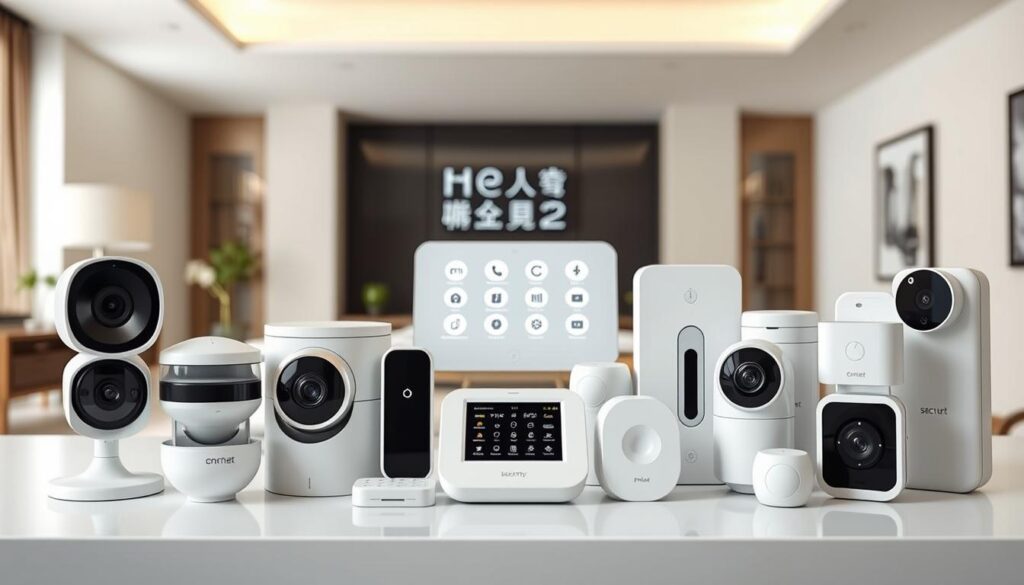
There are many home security brands out there. It’s important to compare their features and services. Homeowners should look at each brand’s strengths and weaknesses to make a good choice.
ADT
ADT is well-known for home security. They offer 24/7 monitoring and advanced home automation. Their systems are reliable and cover a lot.
- Professional installation
- Advanced security features
- High customer service ratings
But, ADT’s services can cost more. Contracts can also last a long time. For more info, check out Security.org for a detailed comparison.
Ring
Ring is popular for its affordable and new security solutions. They have video doorbells and security cameras. Their products are easy to use and work well with smart home devices.
- Affordable pricing
- Easy DIY installation
- Integration with other smart devices
Ring is perfect for those looking for a cost-effective option with great features.
SimpliSafe
SimpliSafe offers customizable and easy-to-install home security solutions. Their systems are flexible and don’t require long-term contracts.
- No long-term contracts
- Customizable security plans
- Easy self-installation
SimpliSafe is great for homeowners who want control over their security without long-term commitments.
Frontpoint
Frontpoint is known for its high-quality home security systems and excellent customer service. Their systems are fully customizable, and they offer professional installation.
| Feature | Frontpoint | Other Brands |
|---|---|---|
| Customization | High | Variable |
| Customer Service | Excellent | Variable |
| Installation | Professional | DIY/Professional |
Frontpoint is perfect for homeowners who want a customizable security solution with great customer support.
Cost Considerations
Knowing the cost of a home security system is key. The total cost includes the initial setup, monthly fees, equipment, and extra charges.
Installation Costs
The cost to set up a system is a big part. Professional installation can cost between $100 and $500. This depends on the system’s complexity and the provider.
A simple system with a few sensors and a control panel is cheaper. But, a system with many cameras and detectors costs more.
A report by SafeWise says the average cost is about $1,300. This includes equipment and installation. It’s smart to get quotes from different providers to find the best deal.
Monthly Monitoring Fees
Monthly fees are another big cost. These fees can range from $30 to $50 a month for basic services. Advanced services like video monitoring and smart home integration can cost up to $100 a month.
For example, ADT and Frontpoint offer different plans. These plans can affect your monthly costs.
Equipment Costs
Equipment costs are a big part of the total cost. The price depends on the equipment’s type and quality. Basic systems have sensors, a control panel, and a siren. More advanced systems include high-definition cameras and smart home devices.
“The cost of home security equipment has decreased over the years, making it more accessible to homeowners. The quality and features of the equipment can significantly affect the overall cost.”
Hidden Fees
Be aware of hidden fees too. These can include activation fees, equipment rental fees, and cancellation fees. Some providers might charge extra for extra services or features. Always read the fine print and ask about any extra costs.
Understanding these costs helps homeowners make smart choices. Having a reliable security system is important. Knowing the total cost helps with budgeting.
Assessing Your Home’s Security Needs
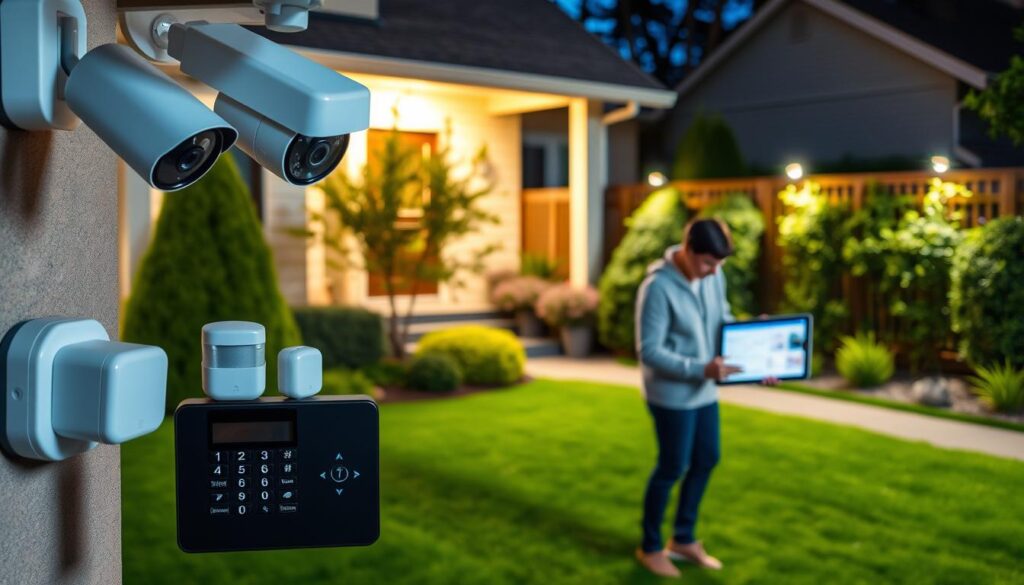
Before you get a home security system, you need to check your home’s weak spots. This helps you pick the right system for your needs. The FBI says there were 1.4 million burglaries in the U.S. in 2020. This shows how important a good security system is.
Evaluating Vulnerabilities
Look for ways intruders might get into your home. Check your doors and windows, and any hidden spots. A well-lit exterior can scare off burglars, who like the dark.
Make sure your doors and windows have strong locks. Think about getting smart locks that you can control from afar and alert you if someone tries to get in. For more info on smart locks, check out this resource.
Neighborhood Crime Rates
Knowing your neighborhood’s crime rate helps you figure out how secure you need to be. Places with lots of crime need stronger security. Look up crime stats on law enforcement websites or community apps.
Neighborhood watch groups can also help make your area safer. Working with your neighbors can make a big difference. Think about starting or joining a local watch program to watch out for odd stuff.
Size and Layout of Your Home
The size and layout of your home affect your security needs. Bigger homes or ones with lots of corners might need more security gear. Make a map of your home to see where you need extra protection.
| Home Size | Recommended Security Measures |
|---|---|
| Small (1-2 bedrooms) | Basic security package with door and window sensors, 1-2 cameras |
| Medium (3-4 bedrooms) | Standard security package with additional motion detectors, 2-3 cameras |
| Large (5+ bedrooms) | Advanced security package with multiple sensors, motion detectors, and 4+ cameras |
How to Choose the Right System
Finding the perfect home security system starts with setting a budget, picking the right features, and reading reviews. With so many choices, it’s key to think about what you really need.
Setting a Budget
First, figure out how much you can spend on a security system. Prices vary a lot, depending on the system, equipment, and monitoring. Think about the upfront costs and monthly fees too. For example, a full system with monitoring might cost $50 to $100 a month. Knowing your budget helps you find a system that fits your money.
Prioritizing Features
Home security systems come with different features. Cameras, motion detectors, and smart home integration are important ones. Think about what you need most. For instance, if you live in a crime-prone area, look for systems with good cameras and alerts.
- Cameras that work at night and in bad weather
- Motion detectors that tell the difference between people and pets
- Smart home integration for easy monitoring and control
Reading Customer Reviews
Reviews from other customers can tell you a lot about a security system. Sites like Trustpilot and Consumer Reports have honest feedback. For example, ADT home security reviews show how well they do and how happy customers are.
“The best home security system is one that you will actually use. Look for systems that are user-friendly and have good customer support.” – Security Expert
Looking at what others say helps you make a better choice. You can pick a system that works well and is reliable.
In the end, picking the right home security system is about balancing your budget, what you need, and what others say. By thinking about these things, you can find a system that keeps your home and family safe.
Installation Process Overview
Choosing between DIY or professional installation is key for a home security system. Both options need careful planning to work right.
Knowing the steps for DIY or professional installation helps you decide. It’s important to be ready and informed.
Professional Installation Steps
Professional installers start by checking your home. They look at your home’s layout and find the best spots for security devices. This includes cameras, sensors, and more.
Next, they install the hardware. This includes door sensors, motion detectors, and cameras. They also set up the control panel and make sure everything works.
If you’re looking for professional installation services, compare providers. Find the one that meets your needs best.
DIY Installation Tips
For DIY, a guide like Wirecutter’s is very helpful. It walks you through each step. Begin by unpacking and organizing your system’s parts.
Follow the manufacturer’s guide for each device. Make sure to place sensors and cameras right. Test each part as you go to catch problems early.
DIY takes patience and focus. But with the right help, it can save money and be fulfilling.
Maintenance of Your Security System
To keep your home safe, it’s important to maintain your security system well. A report by Security Magazine says regular upkeep is key for a home security system to work right.
Regular maintenance includes several important steps. First, you should test your system often to make sure everything is working right.
Regular Testing
Testing regularly helps find and fix any problems with your system. It’s a good idea to test your system every week. This means checking the alarm, making sure sensors work, and seeing if the monitoring system talks to the control center well.
- Test alarm sirens and alerts to ensure they are loud and clear.
- Check that all doors and windows equipped with sensors are properly secured and triggering the alarm when opened.
- Verify that motion detectors are correctly identifying movement within the designated areas.
Updating Security Software
It’s also important to update your security system’s software to avoid cyber threats. Home security systems can get hacked if they’re not updated often.
To keep your system secure:
- Enable automatic updates for your security system’s software.
- Regularly check for firmware updates for all devices connected to your security system.
- Use strong passwords and change them periodically to prevent unauthorized access.
Hardware Maintenance
Keeping your security system’s hardware in good shape is also key. This means checking sensors, cameras, and other parts.
Key hardware maintenance tasks include:
- Cleaning cameras and sensors to ensure they are free from dust and debris.
- Checking batteries in wireless devices and replacing them as needed.
- Inspecting wiring and connections for any signs of wear or damage.
By following these maintenance tips, you can keep your home security system working well. This ensures your home stays protected.
Home Security for Renters
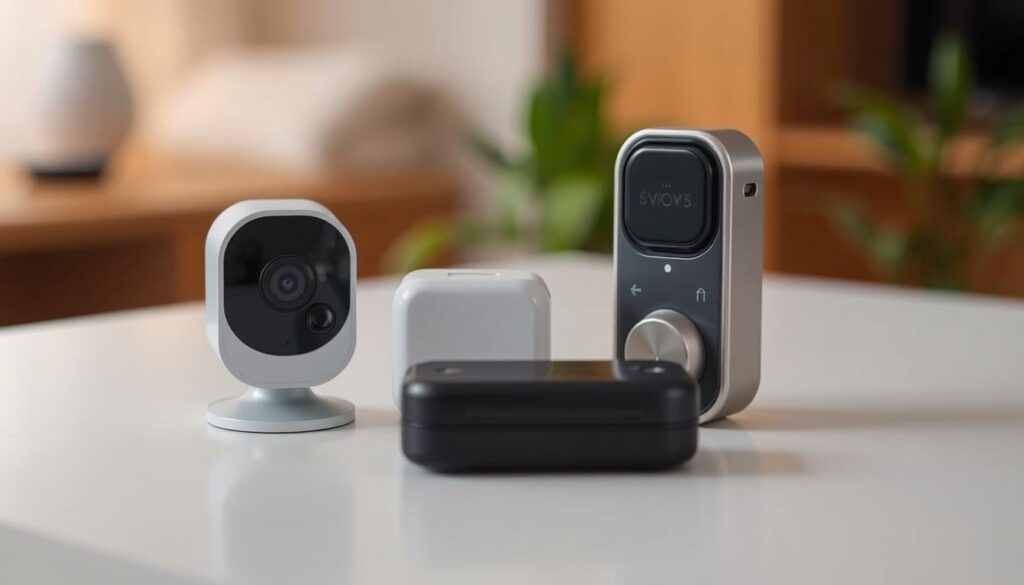
Home security for renters needs a special approach. It focuses on being flexible and finding temporary fixes.
Specific Considerations
Renters have unique security challenges. They can’t make big changes to the property like homeowners can. So, it’s important to find security options that don’t harm the rental.
Some key things to think about include:
- Portability: Security devices should be easy to move when you relocate.
- Non-invasive installation: Avoid solutions that require significant installation or alterations.
- Flexibility: Opt for systems that can be easily upgraded or modified.
Temporary Solutions
For renters, the best security is often temporary. This can include:
- Wireless security cameras that can be placed in various locations around the rental property.
- Portable alarm systems that can be easily set up and taken down.
- Smart door locks that offer enhanced security without the need for permanent installation.
These temporary solutions can provide effective security without breaking rental agreements.
Portable Devices
Portable security devices are perfect for renters. They let you take your security with you when you move. Some examples include:
- Portable security cameras that are battery-powered and can be placed anywhere.
- Smart security systems that can be controlled remotely through a smartphone app.
By picking portable and temporary security solutions, renters can get better security without a long-term commitment.
Legal Considerations
Legal issues are key when setting up home security systems, mainly because of privacy laws.
Setting up a home security system is more than picking the right gear. You need to know the laws that apply. The Electronic Privacy Information Center (EPIC) has a guide on privacy laws for home security. It shows how important it is to follow these rules.
Understanding Privacy Laws
Privacy laws differ by state. Knowing these laws is vital to avoid legal trouble. Laws about video recording, audio surveillance, and data protection are important when using security cameras or monitoring systems.
EPIC says, “Surveillance technologies, like home security cameras, raise big privacy worries.” Homeowners need to know these issues and make sure their systems follow the law.
“The law on surveillance is complex and changes a lot from state to state.”
Necessary Permits
Before setting up a home security system, check if you need permits. The rules for security system permits can change a lot based on where you live.
It’s smart to talk to local officials or a lawyer to figure out what you need. Not getting the right permits can lead to fines or having to take down your system.
By knowing and following the law, including privacy laws and permits, homeowners can make sure their security systems work well and are legal.
Insurance Benefits
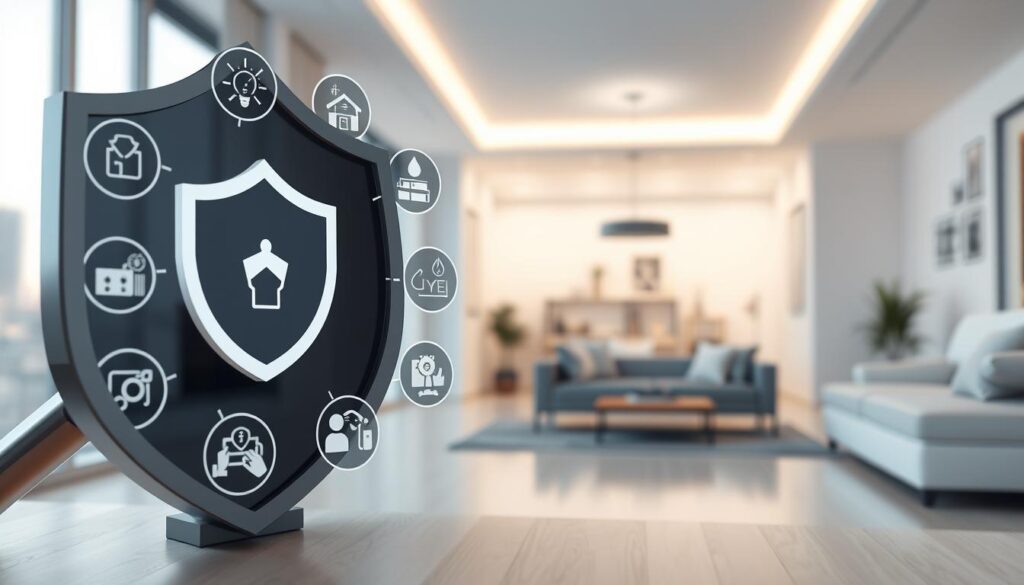
A home security system does more than just protect your home. It also saves you money on insurance. Many homeowners don’t know that a security system can cut their insurance costs a lot.
Insurance.com says many insurance companies give discounts for homes with security systems. The amount of the discount depends on the system and the insurance company.
Discounts for Home Security
Insurance companies give discounts because homes with security systems are less likely to be burglarized. A study by the National Insurance Crime Bureau shows homes without systems are more at risk.
To get the most from your insurance discount, consider these tips:
- Choose a system with cameras, motion detectors, and smart home features.
- Make sure your system is monitored by a professional.
- Tell your insurance provider about your new system to get the discount.
Filing Claims After a Break-In
If your home is broken into, a security system makes filing a claim easier. The footage from your system can help prove your claim.
Steps to follow when filing a claim:
- Report the incident to the police and get a police report.
- Inform your insurance company right away, giving them the police report and any system evidence.
- Work with your insurance company’s investigation, providing any extra information they need.
Knowing the insurance perks of home security systems helps homeowners make smart choices. They can save money on insurance while keeping their homes safe.
Trends in Home Security Technology
Home security is changing fast thanks to new tech. The industry is moving towards safer and easier ways to protect homes.
Smart Home Devices
Smart home devices are making a big difference in home security. Things like smart doorbells, cameras, and locks can be controlled from afar. They give homeowners updates in real-time, making homes safer.
These devices are not just handy. They add an extra layer of protection. For example, smart doorbells let you see who’s at the door without opening it. Smart locks mean you can enter your home without keys and control them from anywhere.
AI and Analytics
A report by Gartner shows big steps forward in AI and analytics for home security. AI systems can look at data from sensors and cameras to spot threats and warn homeowners.
AI helps cut down on false alarms by telling real threats from harmless events. This makes home security systems work better and gives homeowners more peace of mind.
Remote Monitoring
Remote monitoring is a big trend in home security tech. It lets homeowners watch their homes from anywhere, getting alerts and updates right away.
This is great for people who travel a lot or have homes in different places. Remote monitoring adds security and lets homeowners act fast if there’s a problem.
Enhancing Your Home Security
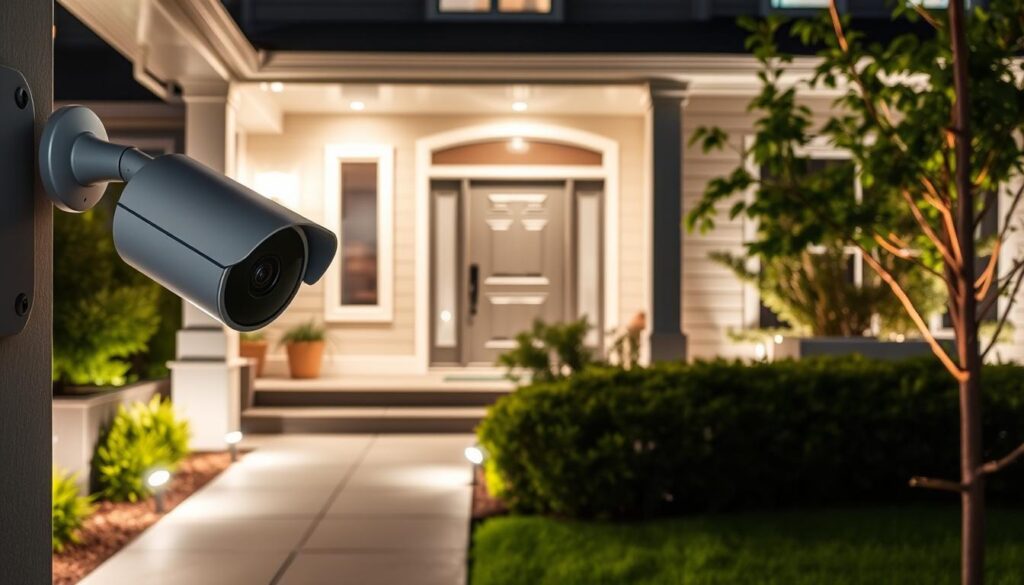
To really secure your home, you need more than just a security system. It’s about a whole approach that includes different strategies and getting your community involved.
Additional Layers of Protection
There are many ways to make your home safer. You can strengthen doors and windows with better locks and security film. Also, brighten up your outdoor area to scare off intruders. And, smart doorbells with cameras can keep an eye on who’s coming to your door.
Strengthening your home’s physical barriers is a big step in stopping break-ins.
- Reinforcing doors and windows
- Improving outdoor lighting
- Using smart doorbells with cameras
Neighborhood Watch Programs
Neighborhood watch programs are a great way to make your community safer. Studies show that areas with active watch programs see a big drop in crime. Getting your community involved is what makes these programs work.
Being part of a neighborhood watch means:
- Working with neighbors to spot and report strange activity.
- Keeping in touch with local police to learn about dangers.
- Teaching others how to prevent crime.
Community Resources
Using what your community offers is also important for home security. Many places have crime prevention classes, discounts on security systems, and training for neighborhood watches. Knowing about these resources helps you use them to your advantage.
By using these methods, homeowners can greatly improve their home’s security. And, they help make their community a safer place.
Conclusion
Choosing the right home security system is key to protecting your family and property. There are many options out there. It’s important to pick one that fits your security needs and budget.
Key Considerations for Home Security
When picking a home security system, think about your home’s size and layout. Also, consider your neighborhood’s crime rates and the features of different systems. A survey showed homes with clear security signs are less likely to be burglarized. This shows the importance of visible security measures.
Investing in Home Security
Investing in a reliable home security system, like those from ADT, can greatly improve your home’s safety. These systems offer 24/7 monitoring and smart home integration. This means you can relax, knowing your home is safe.
In conclusion, home security is essential for keeping your loved ones and property safe. By understanding your security needs and choosing the right system, you can make your home safer. The importance of home security cannot be overstated, and making an informed decision is key to achieving this goal.
FAQ
What is the best home security system company?
How much does a home security system cost?
FAQ
What is the best home security system company?
The best home security system company varies based on your needs. Top choices include ADT, Ring, SimpliSafe, and Frontpoint. Each offers unique features and services.
How much does a home security system cost?
Home security system costs vary. They depend on the system type, equipment, and monitoring services. On average, expect to pay around
FAQ
What is the best home security system company?
The best home security system company varies based on your needs. Top choices include ADT, Ring, SimpliSafe, and Frontpoint. Each offers unique features and services.
How much does a home security system cost?
Home security system costs vary. They depend on the system type, equipment, and monitoring services. On average, expect to pay around $1,300 for equipment and installation.
Are wireless home security systems reliable?
Yes, wireless systems are reliable. They’re easy to install and flexible in placement. Many homeowners choose them.
Can I monitor my home security system remotely?
Yes, many systems allow remote monitoring. You can use smartphone apps to keep an eye on your home from anywhere.
Do home security systems really deter burglars?
A study by the National Institute of Justice found homes without systems are 300% more likely to be burglarized. A system can deter burglars effectively.
What are the benefits of professional monitoring for my home security system?
Professional monitoring adds security. It ensures authorities are notified in emergencies, even if you’re not there.
How often should I test my home security system?
Testing your system regularly is key. It should be tested at least once a month to ensure it works.
Can I integrate my home security system with other smart devices?
Yes, many systems integrate with smart devices. This enhances your home’s security and automation.
Are there any discounts available for home security systems?
Yes, insurance companies often offer discounts for homes with security systems. It’s a smart investment.
What should I consider when choosing a home security system?
Consider your budget, home size, and neighborhood crime rates. Think about the features you need, like cameras and monitoring options.
,300 for equipment and installation.
Are wireless home security systems reliable?
Yes, wireless systems are reliable. They’re easy to install and flexible in placement. Many homeowners choose them.
Can I monitor my home security system remotely?
Yes, many systems allow remote monitoring. You can use smartphone apps to keep an eye on your home from anywhere.
Do home security systems really deter burglars?
A study by the National Institute of Justice found homes without systems are 300% more likely to be burglarized. A system can deter burglars effectively.
What are the benefits of professional monitoring for my home security system?
Professional monitoring adds security. It ensures authorities are notified in emergencies, even if you’re not there.
How often should I test my home security system?
Testing your system regularly is key. It should be tested at least once a month to ensure it works.
Can I integrate my home security system with other smart devices?
Yes, many systems integrate with smart devices. This enhances your home’s security and automation.
Are there any discounts available for home security systems?
Yes, insurance companies often offer discounts for homes with security systems. It’s a smart investment.
What should I consider when choosing a home security system?
Consider your budget, home size, and neighborhood crime rates. Think about the features you need, like cameras and monitoring options.




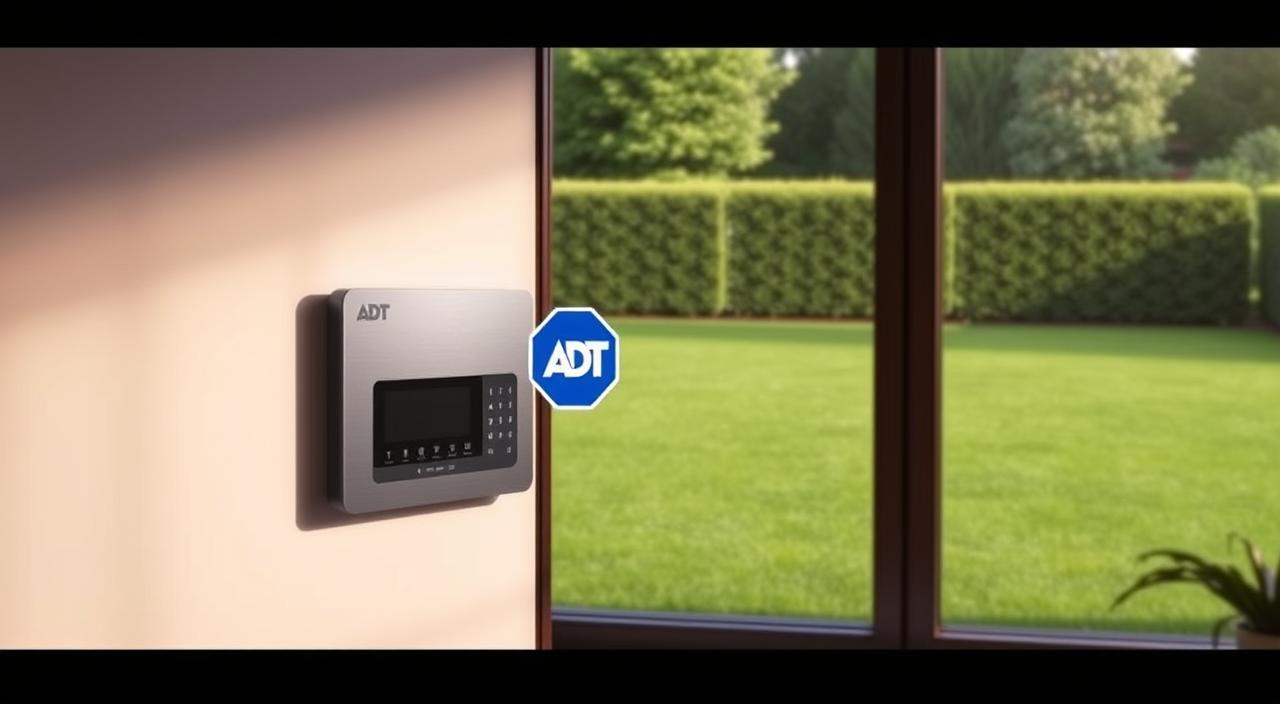

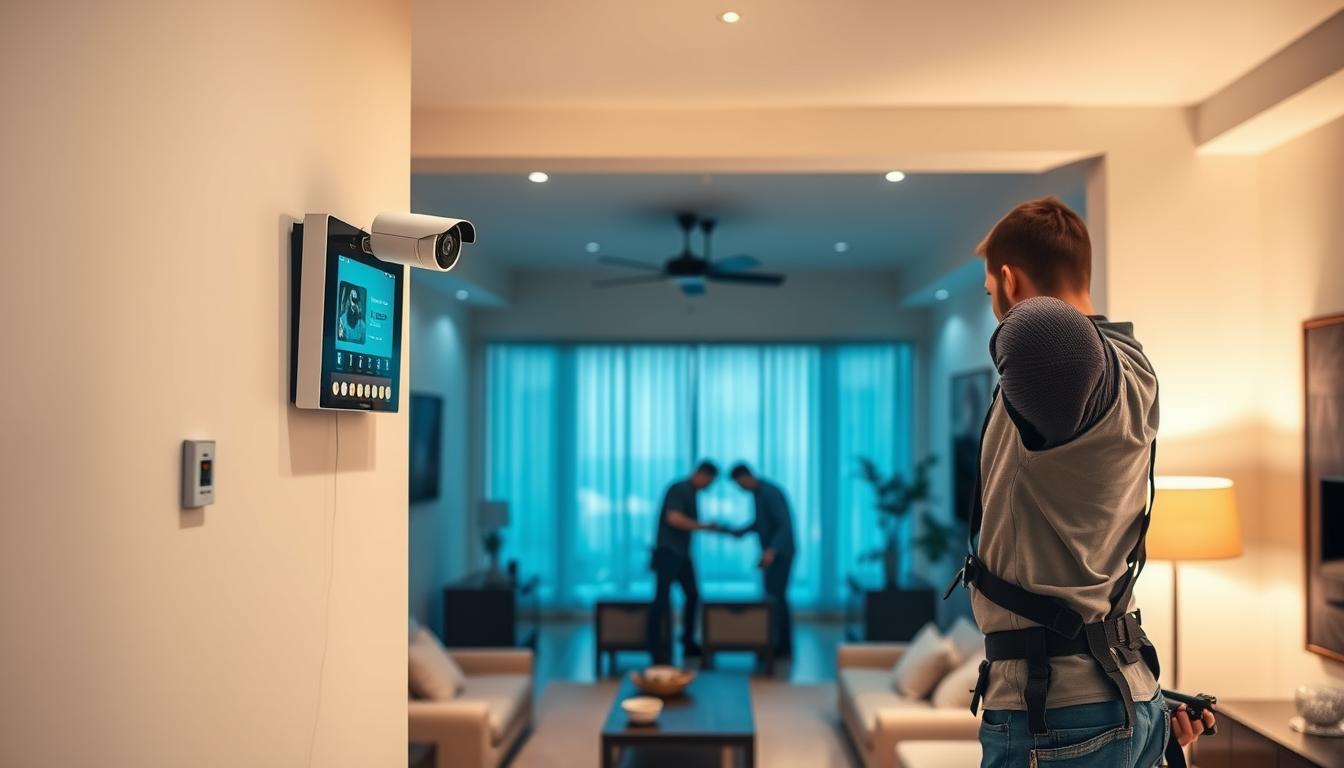
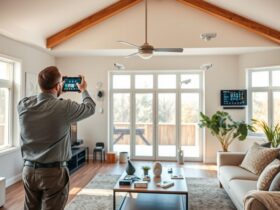
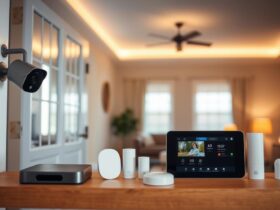
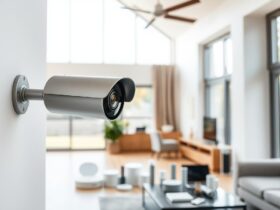
Leave a Reply